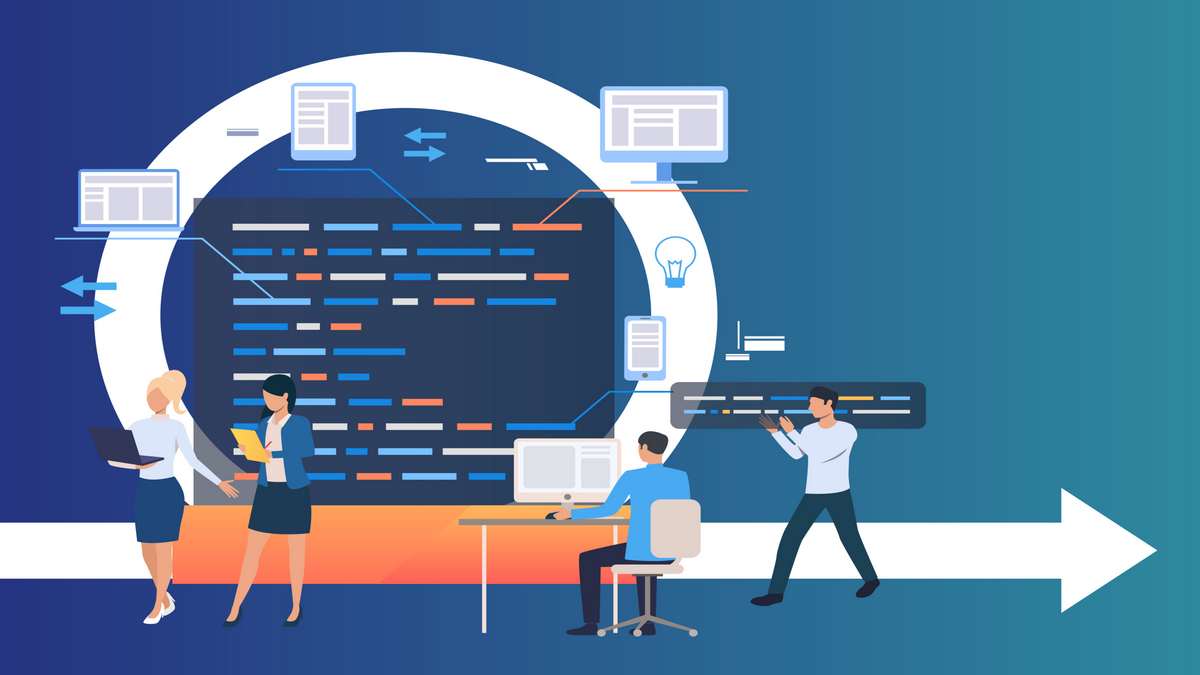
Web development describes all of the processes involved in building and maintaining a website on the internet or intranet. Web developers are tasked with the creation and maintenance of websites and the evaluation of their performance and quality. Some years ago, web development only involved the development of text-based websites and web pages for the internet. However, it has grown to also accommodate the development of web apps that combine the features of mobile and desktop applications.
Also, web development now integrates images, videos, and other interactive content in web pages, web apps, and websites, generally. A lot of technologies go into the creation of websites, and these technologies keep on evolving to ensure that these websites meet up with technological advancements. Sometimes, these technologies are updated faster than they can be implemented. Therefore, developers must be familiar with the latest trends to retain their relevance in the web development industry and even more so if you are just starting your career in freelance web development. Adapting to the latest trends can also be beneficial for businesses as it helps them to keep up with their competitors and attract new customers.
Refusal to follow the current trends in web development can affect the performance of your web pages, web apps, and websites, ultimately affecting the user experience. This may cause you to lose users to competitors who provide better services and user experience by staying up to trends. Therefore, in this article, we will be discussing the current trends in web development that will put you one step ahead of your competitors and help you stay updated.
Types of Web Development
Since the advent of the internet in 1983, there have been several web development tools that help to simplify the process and cost of creating and maintaining websites. These tools include frameworks, programming languages, databases, operating systems, etc. There are two major types of web development. These include:
1. Frontend Web Development: The front end of a web development service, also known as the client-side, is the part of a product that deals with the aesthetics, user interface, and every part of the webpage, web app, or website that the user can see and interact with. Tools involved in frontend development include:
- HTML: HTML is an acronym for HyperText Markup Language. It is a front-end web development tool that is used to structure a web page and its content. While HTML is not considered a programming language, it is regarded as the official web standard. However, HTML is not enough to develop and maintain a website. It is assisted by other tools such as CSS and JavaScript.
- CSS: CSS is an acronym for cascading style sheets. It is a style sheet language that is used to describe the presentation of a document that is written in a markup language such as HTML (HyperText Markup Language). CSS helps to style colors, layouts, fonts, etc, to fit the screens of various devices.
- JavaScript: What is JavaScript? JavaScript is the programming language for the web. It is a scripting language that allows developers to install complex features on a webpage. Javascript can be used to update and change both HTML and CSS. It is present in 97% of websites as a client-side programming language and can be used to manipulate, calculate, and validate data.
2. Backend Web Development: The backend of a web development service is the opposite of everything the frontend stands for. It is also known as the server-side and it deals with the parts of a product that the users cannot see or interact with. It is concerned with the building and maintenance of the codes that run a website. Backend web development covers web servers, databases, operating systems, frameworks, APIs, libraries, etc. Server-side languages involved in backend web development include:
3. Python: Python is a high-level backend programming language that is used to automate data, build websites and software, and carry out data analysis.
4. PHP: PHP is a general-purpose scripting language that is specifically designed for website development. It is able to handle a large amount of data on the server side, therefore, it allows web development to run smoothly regardless of the bulk of the data being dealt with.
5. C#: C# is a high-level programming language that allows developers to build many secure and robust products. It is one of the most popular backend languages that is used to develop mobile, desktop, and web applications.
6. C++: C++ is a high-level cross-platform language that can be used to develop high-performing applications such as web browsers, games, operating systems, etc. C++ can also function as a backend programming language for tasks that require high-performance processing.
Importance of Web Development Trends
As a developer or business owner, it is important to stay updated on web development trends. The following are reasons why web development trends are important to know:
- Product quality: Your webpages, web apps, and websites must match those of your competitors in terms of quality. If you are unaware of new trends in web development that can help to improve the appearance and functionality of your product, it might cause you to lose users to competitors who have already improved their product quality by implementing the latest trends. About 38% of a website’s visitors will stop engaging the website if it has an unattractive layout or content.
- User experience: Trends in web development are meant to make web development easier and create better web pages, web apps, and websites. A better website improves the user experience with your products; therefore, it is important to keep up with these trends.
- User base expansion: Keeping up with the latest web development trends can help to expand your user base. Implementing the latest web development trends that might have been ignored by other people can attract more customers to your product and lead to more revenue.
- Expertise: As a developer, keeping up with the latest trends in web development helps to enhance your expertise. It also portrays you as versatile and can help you to secure more development jobs easily.
- Credibility: According to Kinesis, 75% of consumers admitted to judging a website’s credibility based on the layout and design. Therefore, refusing to keep up with trends that can transform your website’s appearance for good might portray your business in the wrong light.
Top Current Trends in Web Development
1. Progressive Web Apps (PWA)
The progressive web app technology is a very important trend in web development. It is a web app that has the appearance and functionality of a real mobile app. This application software is built using popular web tools such as HTML and Javascript. It works on any device with a normal browser and it offers a high user experience.
Benefits of the PWA in Web Development
- Simple installation
- Low development costs
- Quality user experience
- Increased device storage and power efficiency
- Easy to update
Best Examples of Progressive Web Apps: Starbucks, BMW, and Uber.
2. Accelerated Mobile Pages (AMP)
Accelerated Mobile Pages is one of the most popular website development trends. It is the result of a collaboration carried out between Twitter and Google in a bid to create faster mobile pages. AMP-optimized pages load easily, therefore, they rank better than other mobile web pages. AMP pages load about 20 times faster compared to non-AMP pages, which may take up to 22 seconds to load.
More developers are now embracing AMP because of its user-oriented technology. It prioritizes user experience and retains existing users. Furthermore, by implementing AMP technology, companies can now save costs on UX and attract users with low internet speeds. The user-oriented technology was created to encourage small businesses by enabling them to build websites that work smoothly across different types of mobile devices.
Benefits of AMP in Web Development
As a web developer, you can enjoy the following benefits from AMPs
- No need to create sitemaps to be identified by search engines.
- Easy optimization for search engines.
- Low bounce rates.
- It can adjust to any browser.
Examples of early users and adopters of AMP technology include CNBC, The Washington Post, etc.
3. Voice Search Optimization
Voice search optimization can be simply defined as the process of optimizing web pages to appear in voice search. Due to the influence of voice assistants and IoT, devices that use voice recognition are becoming more popular. The technology has witnessed so much growth that these devices will be able to recognize the voices of different people and provide a personalized AI-based experience, in the years to come. The most recent advancements in web development include voice-activated self-standing gadgets and voice-optimized apps and webpages.
Voice recognition helps us multitask and saves us time as more devices become AI-enabled. By 2023, 8 billion digital voice assistants are predicted to be in use worldwide. Voice search optimization will become indispensable in the list of the newest web development technologies as a result of the enormous expansion.
Benefits of Voice Search Optimization in Web Development
The following are ways through which voice search optimization is of benefit to web developers:
- Quicker replies to customer queries
- Effectiveness of local SEO campaigns
- Develop more trust and customer loyalty.
Examples of early adopters of voice search optimization technology include Alexa (Amazon), Google Assistant, etc.
4. Push Notifications
Push notifications are clickable pop-ups that are used to provide various types of information to users as they browse web products. This trend can be implemented on various types of devices including phones, tablets, and laptops. Push notifications are very powerful as they can be used to catch users’ attention and get them to take the desired action.
It is already in use by big tech giants in their web applications. It helps companies to pass information such as promotions, offers, and notifications to their users quickly. Push notifications have proven to increase user experience, and click rates, and drive users to a website. It is a very important trend that is becoming very popular.
Benefits of Push Notifications in Web Development
Push notifications help web development in the following ways:
- It enhances user experience.
- It drives visitors and improves click rates.
- It promises more ROI to clients.
Early Adopters of the push notification web development trend include Amazon and Buzzfeed.
5. API-first Development
As its name implies, API-first development gives significant importance to APIs. As new technologies are developed, connections must be made between them, which is made possible by APIs. Although APIs have been around for about 20 years, in the past, developers used to prioritize the creation of new products. The establishment of a connection between the software and the hardware used to be of low priority.
Nevertheless, there are benefits attached to API-first development. The major benefit is that it is user-oriented. API-first development allows developers to work concurrently, thereby cutting down on the time and expenses spent during development. Additionally, it lowers the likelihood of failure and this ensures that all APIs are consistent and dependable. Therefore, API-first development is becoming an increasingly popular trend in web development lately.
Benefits of API-first model in Web Development
The API-first technology is developer-friendly. Other benefits derived from this trend include:
- Reduction of the learning curve of developers as well-documented and consistent APIs are provided.
- APIs are reliable and consistent, thus reducing the risk of system failure.
- Stakeholders can provide feedback on the design of an API before any code is written.
Early adopters of API-first technology include Netflix and Etsy.
6. AI-Powered Chatbots
An AI-powered chatbot is a smarter and more advanced version of regular chatbots. The technology uses natural language processing (NLP) and machine learning (ML) to understand user intent better and provide a human-like experience. Advanced features like behavior analytics and all-day problem-solving skills are available in AI-based bots. Experts predict that self-learning bots will become indispensable in the future and they can replace support managers, thereby cutting costs for companies. It is simple to incorporate an AI-powered chatbot into both conventional/professional websites and PWAs.
The AI chatbot trend is considered to be a worthy investment in the long term because of its abilities. AI chatbots can answer FAQs, connect users with the right human assistant, and even take orders. Chatbots generally provide quick answers in emergencies and resolve complaints quickly.
Benefits of AI-powered Chatbots in Web Development
The following are the benefits of AI chatbots to clients and developers:
- Make development easier by replacing navigational website elements.
- Provides exceptional user experience.
- Develop fewer applications as chatbots are integrated with messengers.
Examples of early adopters of the AI chatbot web development trend include Nestle’s NINA and HDFC Bank’s EVA.
Conclusion
Staying up-to-date with current trends in web development is a surefire way to ensure you deliver the best web products and improve the customer’s experience.



